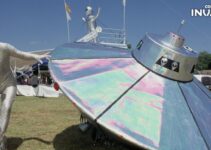A Harvard professor discovered mysterious metal-rich spherules at the bottom of the ocean.
He controversially said their unusual composition meant they might be alien technology.
Many scientists disputed this claim, and one now says they may just be industrial waste.
A Harvard professor’s claims that metallic balls discovered under the ocean may have been made by aliens have been called into question yet again.
In July, Avi Loeb, the director of a computational-astrophysics center at Harvard, said spherules dredged from the Pacific Ocean were left behind by a meteor that exploded near Earth in 2014.
Their bizarre chemical makeup, he said, suggested they could be a form of alien technology.
The statement drew criticism from parts of the scientific community, who said Loeb was being too bold and too hasty in his assertions.
Now, an analysis may offer a more down-to-earth explanation for the mysterious spherules: They may simply be an offshoot of coal burning.
Spheres from industrial waste
Patricio Gallardo, a research fellow at the University of Chicago, analyzed the chemical composition of coal ash, a waste product left behind by the combustion of coal in power plants and steam engines.
As a reference, Gallardo used a publicly available coal-chemical database called Coalqual.
His analysis, he said, found that iron, nickel, beryllium, lanthanum, and uranium concentrations reported by Loeb and colleagues in the metal spherules were “consistent with expectations from coal ash from a coal chemical composition database.”
“The meteoritic origin is disfavored,” Gallardo wrote.
Gallardo’s analysis was published in a journal that is not peer-reviewed.
“Well, they did indeed discover evidence of a technological civilization…right here on Earth,” Caleb Sharf, the senior scientist for astrobiology at NASA’s Ames Center, wrote in a post on X earlier in November.
In a post on Medium published Thursday, Loeb said the coal-ash theory was “based on unrefereed comments that superficially examined a few elements out of the dozens we analyzed.”
“To be scientifically credible, any such claim must reproduce the measured abundances of all elements and, in particular, demonstrate the loss of volatile elements — as derived in our paper,” he continued.
Loeb provided several rebuttals to the analysis. He quoted his team member Jim Lem, the head of the department of mining engineering at the University of Technology in Papua New Guinea, as saying: “The region where the expedition was carried, should have no coal mineralization.” He also said the spherules had more iron than coal ash.
Where did the mysterious metal spherules come from?
Loeb’s decision to seek out these spherules came from a high-stakes gamble.
The New York Times reported that the scientist’s team had uncovered partially classified governmental records suggesting an object had exploded near Earth in 2014.
Their analysis, as well as a letter from US Space Command, suggested the fireball could have come from an object that had traveled from interstellar space, the Times reported.
This left Loeb wondering whether the 2014 object was an extraterrestrial probe, the outlet reported.
To test his theory, the Times reported, Loeb went to great lengths to recover debris from the object, which would have landed near Papua New Guinea. He commandeered a magnetic “rake” that could dredge under thousands of feet of water, an expedition that received $1.5 million backing from a cryptocurrency magnate, the outlet reported.
This isn’t Loeb’s first foray into the murky world of alien hunting. He also said ‘Oumuamua, a rare interstellar rocky object shaped like a cigar that flew in a bizarre pattern as it passed Earth, was probably a piece of alien tech. The claim has been heavily disputed.
The Papua New Guinea expedition could have failed if the spherules weren’t magnetic, the Times reported. But the team recovered hundreds of metallic spherules, tiny spheres that are the hallmark of debris left behind when molten rock burns through the atmosphere.
Five of the 57 spherules analyzed from the bunch were indeed bizarre, Loeb and his coauthors said in a paper published online in August, which has not been vetted by peer review.
They were made of an excess of beryllium, lanthanum, and uranium, a “never seen before” composition for the tiny spheres, the paper said. It also said the spheres carried bizarre iron isotopes, versions of atoms, which altogether were “supporting its interstellar origin.”
Dubbing these five spherules BeLaU, Loeb and his colleagues went an extra step in their interpretation. They said in their paper that these “may reflect an extraterrestrial technological origin,” though they said the claim required further investigation.
The fragments “could be a spacecraft from another civilization or some technological gadget,” Loeb told CBS News.
A controversial take
Many scientists quickly distanced themselves from Loeb and his colleagues’ interpretation.
Some agreed that the bizarre composition of the BeLaU spherules could suggest an extraterrestrial origin but questioned the claim they were necessarily made outside the solar system. Others analyzing the 2014 object disagreed that it would have come from interstellar space and suggested the spherule composition could have come from the solar system.
Loeb disagreed with those he called his “lazy critics.”
In answer to a request for comment from Business Insider, Loeb said coal ash wouldn’t have been magnetic enough to be picked up by the dredging equipment they used to collect them, which used magnets.
He said his team’s own analysis comparing the composition of the spherules with coal ash, conducted by his collaborators Stein Jacobsen at Harvard University and Roald Tagle from the Bruker Corporation in Germany, “found the two to be completely different in many elements, including iron, silicon or aluminum.”
“There is no way that the two can be confused for one another. We are bewildered that the association of our spherules with coal ash was even suggested,” he said.
He added that his research teams were analyzing the remaining 93% of the nearly 800 spherules collected.
“It is surprising that anyone would state decisively that the spherules are coal ash without having access to the materials,” he told BI.
“The only way to determine the nature of the spherules is through a careful scientific analysis, which we are currently conducting with the best instruments in the world,” he said.
Loeb said a full analysis of the composition of the spherules would be reported once it’s finished.
Gallardo did not respond to requests for comment.
Correction: November 20, 2023 — An earlier headline in this story incorrectly described the Harvard professor Avi Loeb’s remarks about the metal spherules found in the ocean. He said that they might be alien tech, not that they definitely were.
Read the original article on Business Insider

